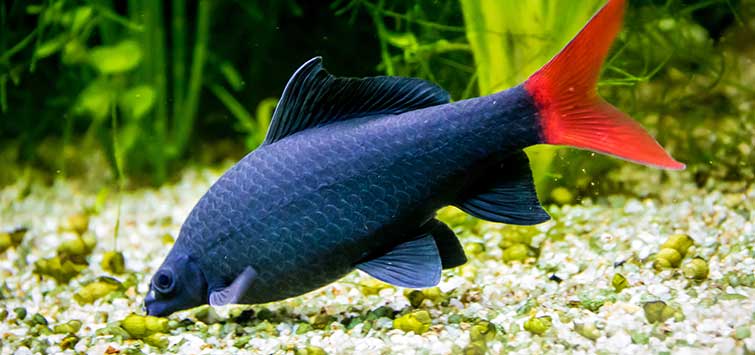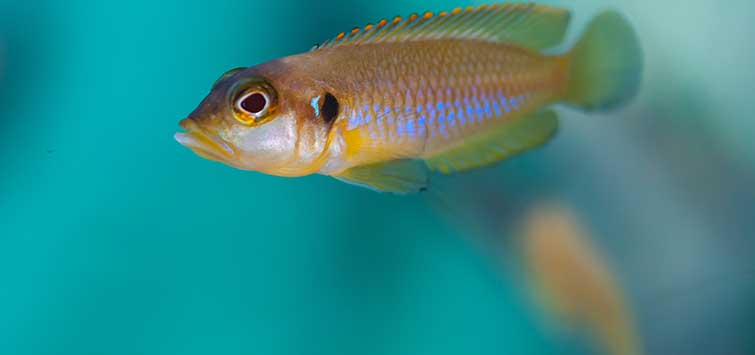Finding Furu in Tanzania: Lake Victorian Cichlids in the Mwanza Region
Author: Lawrence Kent
Our international traveler visits Lake Victoria to collect local cichlids and other interesting fish.
Traveling to the Hotel Tilapia
When I learned that I’d been booked into the Hotel Tilapia on Lake Victoria for my stay in the Tanzanian city of Mwanza, I realized this business trip had great potential. It was October 2009 and I was traveling to the region to help Catholic Relief Services monitor a project designed to help poor farmers increase their production of sweet potatoes and cassava. I would have two free evenings and one Saturday to look for fish while I was there.
I realized that luck was on my side when I checked into the hotel and the receptionist handed me a key for room 5 with a tag labeled “Furu.” The small hotel had named each of its rooms after one of the groups of fish in the lake, using the local Swahili terms: furu (haplochromines), dagaa (lake sardines), sato (tilapines), sangara (Nile perch), and so on. I hadn’t asked for the furu room, so I smiled when she handed me the key. I love keeping these hardy tropical fish at home in my aquaria, and I also love finding them in the wild.
That evening I walked 100 yards down a dirt road that was cut through a cemetery and came upon a small fishing village nestled between huge piles of boulders. I later learned that the area is known as Capri Point. I followed the boulders down to the lakefront and asked the handful of Tanzanians I found there if they could help me find furu, showing them the pictures in Ole Seehausen’s book Lake Victoria Rock Cichlids (Verduyn Cichlids, 1996).
They said, “Not now, come back tomorrow,” or something like that—I don’t speak Swahili, and their English was minimal. Then a woman showed me a rather dry and dead cichlid with an orange belly and yellow caudal peduncle, probably a Paralabidochromis. I told her I needed live ones. The situation looked promising, so I said I’d return the following evening to look for some. I walked back to the hotel through the cemetery in the dark, feeling a bit vulnerable and worried about being robbed.
Rock Cichlids at Capri Point
The next evening I went back to the lake and told the boys I found there that I would pay 500 Tanzanian shillings (about 75 cents when I was there) for each furu they caught. They quickly found their poles and dropped hooks and lines between the boulders and through the water hyacinth floating near the shore. Soon they were pulling up cichlids and dropping them into my bucket.
According to Seehausen’s book, the local term for these rock-dwelling cichlids is mpipi, but when I employed the term with these locals (thinking I could impress them with this local vocabulary) they looked at me with puzzled expressions—none of them knew what it meant. They seemed to prefer the generic name for Lake Victoria’s small cichlids: furu.
Catching Furu
I took pictures of the furu immediately after they were caught and then put them in buckets so I could take more pictures later in my hotel room, where I had a small glass photo tank. The diversity of cichlids in Lake Victoria (over 500 closely related species, mostly undescribed) makes it difficult to identify individual specimens. Distinguishing characteristics can be subtle, involving the shape of the teeth, the ratio of various head measurements, and the shape of the jaw. I started emailing my photos to Greg Steeves right away, directly from Mwanza. Greg heads the Lake Victoria CARES (Conservation, Awareness, Recognition, Encouragement, and Support) project, and he has considerable expertise in this species flock. His help was critical to identifying some of the catch, albeit tentatively.
Almost all of these small cichlids were classified in the genus Haplochromis until P. H. Greenwood, whose life work centered on these fish, split that genus into 17 new genera. This splitting proved controversial with taxonomists. Some continue to use the original unified genus of Haplochromis, others use Greenwood’s genera as published, and others use them as subgenera or as species groups.
The Rockpicker Type
One of the first fish we caught at Capri Point was deep bodied and dark blue and turquoise, with dusky-red unpaired fins and orange egg dummies on the anal fin used to attract female attention during spawning. The fish was about 4 inches long with an indented dorsal head profile and upturned mouth, leading Greg to surmise that the fish was probably a “rockpicker type,” maybe an acidens type, and an insectivore. I would love to have been able to transport this pretty fish home for my tank, but my travel schedule and the fish’s 5-inch size made that impossible (smaller fish tolerate shipping better).
More Unique Fish
Another good-looking fish caught at this spot was similarly deep bodied but more vibrantly colored, having red edging on its unpaired fins, a vertical black bar in its tail, and metallic-blue lips. I photographed it in my small photo tank and consulted with Greg, who said, “The only fish that I know from anywhere near there is something Ole Seehausen called Paralabidochromis sp. ‘southern pseudorockpicker.’ This fish does not share the vibrant coloration that yours shows, but the black vertical line on the caudal fin is really unique. Body shape, eye bar, and other characteristics match up perfectly. What an incredible fish!”
A third fish snagged among the rocks was less deep bodied and almost salmon in color (perhaps due to stress) with light-blue and red-edged unpaired fins. It had a slightly convex dorsal head profile and metallic-blue lips and cheeks. After he examined the photo, Greg said this fish resembled a color form of Psammochromis riponianus from Senga Point. That species feeds primarily on large insect larvae, such as those of the caddis and mayfly. Greg emailed me to ask if the teeth were curved (like the end of a leaf rake) toward the throat, as this would be a tell-tale sign for identification. Unfortunately, I’d already returned the fish to the lake by the time I downloaded his email.
Batman and Lungfish in Nyegezi Bay
The next day of work involved visiting the Tanzanian government’s Lake Zone Agricultural Research and Development Institute (LZARDI) in Ukiriguru—a place crawling with lizards, including bright pink-and-purple agamids. While I was there, the topic of fish came up and one of the agronomists mentioned that the Tanzania Fisheries Research Institute (TAFIRI) was nearby, on the road back to Mwanza.
We stopped there that afternoon and asked about seeing some furu. The acting director, Batman Msuka, received me warmly. Batman agreed to provide a small skiff, a long gillnet, and two workers for a fee. An hour later, those workers and I were out in muddy Nyegezi Bay, pulling up the gillnet, while a dozen pied kingfishers hovered overhead.
Fresh Catches
We caught about three dozen haplochromines and tilapines. Among them was a dusky bluish-green cichlid with a steep and curved cranial profile, a small sturdy head, smoky magenta dorsal and caudal fins, and an anal fin adorned with black-orbited orange egg spots. According to Greg, it was almost certainly Ptyochromis xenognathus. The Ptyochromis genus was established by Greenwood in 1980 for a group of snail-eating cichlids that crush their prey with their oral jaws, differentiating them from the Labrochromis, which crush snails in their pharyngeal mills (throat jaws).
A second, moderately elongate cichlid was yellow with five faint vertical bars and a steep convex dorsal head profile. Greg shared the photo with his friend Dr. Yves Fermon, who has spent a lot of time in the Mwanza region collecting cichlids, and he guessed the fish to be a female Ptyochromis fischeri. Greg immediately emailed me a journal article on this species, explaining how females were yellow while males were mostly blue. The fish reportedly like to stay close to shore and take refuge in papyrus, which was indeed growing a few yards from our collection site.
A third cichlid was silvery yellow, about 3½ inches long, with an unusually long, pointed, and slowly sloping head. Greg said he couldn’t identify the fish in the photo, but noted that its head resembled some of the Yssichromis species. This is one of the genera that has made a resurgence—a few years ago most species were thought to be extinct. But most Yssichromis are slender fish, not nearly as robust as this pointy cichlid we’d caught in Nyegezi Bay.
While we were pulling up the final section of the net, a storm rolled in and blew our skiff into some thorny bushes on the heavily vegetated shore. We untangled our clothes and nets from the thorns and headed back to the dock in the rain. The workers, Gerard and Emwere, handed me the bucket of fish and we ran up to a warehouse at the research station to examine them more closely.
Taking a Closer Look
Batman met us there, pulled out the three tilapines, and lined them up on the floor to give me a lesson. The one on the top, he explained, can be recognized as Oreochromis niloticus by the vertical pinstripe barring in its tail. It is a mouthbrooder and a robust, introduced species that outcompeted the native tilapines O. variabilis and O. esculentus, making these native fish rare. The second and third fishes, he went on to explain, are true tilapias, which are more primitive nest spawners, although also introduced species. Tilapia zillii has broad, black barring, and T. rendalli is known as the red-bellied tilapia (although the one I saw didn’t show much red).
Batman also pulled from the bucket a young Nile perch Lates niloticus, the fierce furu-gobbling predator that was introduced into Lake Victoria in the 1950s for sport fishing. By the 1980s, the Nile perch had established itself in such great numbers that a thriving inland fishery was created due to its commercial value as a food fish. It has thrived in the lake and contributed to the extirpation of probably 200 of its endemic haplochromine species.
Gerard and Emwere smiled when I told them I wouldn’t be taking any of the catch with me—they realized that all of these fish would be theirs to take home to boil and eat.
Batman then drew my attention to a big cement tank filled with water housing a giant eel-shaped lungfish Protopterus aethiopicus, probably 4 feet long and 25 pounds. “Don’t put your hands near or he’ll bite you,” he explained, throwing in a couple of furu for it to devour. I later saw several of these lungfish in the lake, gulping air at the surface with lungs similar to those found in early amphibians and then rolling over, dolphin-like, as they dived back down toward their lairs at the bottom.
Patience Pays Off on the Beach
Saturday finally came. I had hoped to hire a boat to visit some of the rocky islands described in Seehausen’s book, but the hotel told me that a boat would cost $90 an hour, so I hired a much cheaper taxi instead. I told the driver to take me to some rocky shoreline areas to find fishermen—someplace like Bwiru Point, which looked to be nearby on the map in Seehausen’s book. The driver gave me a blank stare; he didn’t speak a word of English. But he knew someone who did, and we were soon joined by his English-speaking Tanzanian friend. We drove about 10 miles north to a sandy beach next to a brewery, to a place called Pasiansi (“Patience”).
There we found a dozen fishermen, waist deep in water, pulling a 60-foot gill net to shore. When we asked for furu, they explained that the mesh on their net was too big to trap little fish (furu rarely exceed 5 inches in length). One of them, an old man named James, spoke English. “Come back at 2 p.m.,” he suggested. “We should be able to catch a few pieces by then.” I was already getting sunburned, so I didn’t mind this opportunity to go back to the hotel for a couple hours of shade.
Street Market Findings
On the way to the hotel, we stopped at a street market to check out the fish. We found women selling piles of dead cichlids—about 10 furu for 75 cents. I photographed a few, and Greg Steeves helped me identify a bright-yellow Neochromis species found at the bottom of one of those piles. We also found a fisherman with a long-nosed elephantfish Mormyrus kannume (about 15 inches long), a yellow- and blue-spangled cylindrical carp Labeo victorianus (endemic to the lake), and a live Lake Victoria squeaking catfish Synodontis victoriae (about 9 inches long) with nicely spotted gray flanks.
Back at the Beach
When we returned to Pasiansi Beach, James announced, “We only have four pieces now, but if you can wait another 45 minutes, we’ll get more,” and he pointed to a wooden skiff containing three fishermen 200 feet off shore.
While waiting for the skiff to come in, I dipped my hand net into a flooded furrow in an adjacent field of sweet potatoes and came up with a couple of ½-inch cichlid juveniles. I popped them into a breathable bag, handed the net to a group of six-year-old boys, and asked them to catch me a bunch more. They set to work immediately but had to move to a flooded cornfield when the owner of the sweet-potato patch arrived.
Results
In the end, the boys captured about two dozen tiny fish, which I later brought back to my hotel room. I was excited about the prospect of transporting them home to the States and growing them up in my basement aquaria. I believed I would have a good chance of developing a breeding group of a single species, hopefully a new and undescribed species of furu, and the “furu fanatics” of Texas would finally invite me to speak at one of their club meetings.
Unfortunately, things were not to work out that way. Half of the tiny fish died during the 30-minute taxi ride to the hotel (these were the precious furu fry). Closer examination of the fish that were still alive revealed that they had tell-tale tilapia spots on their tiny dorsal fins. These survivors were probably the common and undesirable Nile tilapia Oreochromis niloticus. That species is clearly more robust than the haplochromines. Bad luck.
Cichlid Findings
Back on the beach, the wooden skiff came to shore and the fishermen handed me a bucket containing two dozen cichlids. I sat in the shade of a nearby beached boat, closely surrounded by 20 curious onlookers, and went through the catch, photographing the fish in my hand and in a glass photo tank.
One of the fish was deep bodied and grayish blue, with six vertical black bars and a convex cranial profile. It had yellow egg spots on its anal fin and some red edging on its tail. I shared its photo with Greg who noted its “lightning bolt” eye bar, often seen in Astatotilapia-like fishes, and its exceptionally large mouth. Greg speculated that it could be from the Greenwood-created subgenus Cleptochromis (Lipochromis parvidens type) but admitted that he really couldn’t tell.
A second fish in this batch was bright yellow with a steep dorsal head profile and three orange egg spots on its yellow anal fin. It was likely another Ptyochromis fischeri female, as this species is said to like sandy habitats. This species, which was formally known as P. sauvagei, feeds by carefully approaching a moving snail and, when just a few millimeters from its prey, turns its head sideways, waiting for a suitable moment to make a sudden bite into the snail’s soft body. The fish then jerks its head to tear the snail’s body away from its shell.
Leaving Tanzania
The following morning I had to depart. I handed my room key back to the receptionist and headed to the airport. I was traveling from Tanzania to Uganda, so the flight took me right over the lake. I looked out the window and saw Pasiansi Beach as well as the rocky islands I’d been unable to visit. The huge dimensions of Lake Victoria became apparent as we flew high above it—it’s Africa’s largest lake and the third largest in the world. I felt blessed by the short opportunity I had in Tanzania to meet some of its fascinating furu.
See the full article on TFH Digital http://www.tfhdigital.com/tfh/201008/#pg69

.png?h=595&iar=0&w=2781&hash=5FD5E69473BCC22199FBFA2FB71B6033)



